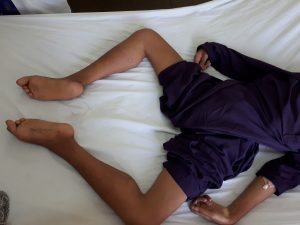Duchenne Muscular dystrophy is an X-linked congenital disorder where the genes are inherited from an affected parent.
It is a disorder affecting primarily the skeletal muscles leading to progressive muscle weakness. Since the dystrophin gene is present on the X chromosome, it mainly affects the males.
A young child with Duchenne muscular dystrophy
A 13 years of age boy, who was a diagnosed case of Duchenne muscular dystrophy, presented with fever and cough of one week’s duration.
The patient was diagnosed as a case of Duchenne muscular dystrophy at the age of 6 years when he had difficulty in walking. This was also associated with frequent falls including a fall from stairs. He left going to school at an early age as he became progressively bed bound.
Now, this time he presented with fever and productive cough. He was short of breath and could not maintain oxygen saturation. He was started on broad-spectrum antibiotics, bronchodilators, and chest physiotherapy.
Because of the respiratory muscle weakness, the patient could not expectorate. Regular chest physiotherapy along with manual suction was continued.
Healthy patients with pneumonia improve rapidly, however, patients with muscular dystrophy take a long time to get better. Furthermore, they need more efforts and support as sputum accumulation and a prolonged hospital stay might lead to other superimposed hospital-acquired infections.

DMD genetics:
The disease is caused by a defective gene present on the X chromosome responsible for the production of dystrophin. Dystrophin is a large protein present in the skeletal muscles.
Duchenne muscular dystrophy symptoms:
It is characterized by muscle weakness that may be noticed at an early age. Although the histological features may be present at birth, clinical features manifest by the age of 3 years.
Weakness in DMD:
Weakness is seen primarily in the proximal muscles of the body. This is manifested by difficulty in getting u from squatting posture, combing hair, walking, Jumping, and running.
Children may develop a waddling gait. The weakness may progress over time so much so that the patient becomes wheelchair dependent by the age of 12 years.
Heart involvement in Duchenne Muscular Dystrophy:
Because the skeletal and respiratory muscle weakness dominates the clinical features in DMD, cardiac muscle involvement may be missed. Rarely, cardiac muscle involvement dominates.
Patients with DMD have progressive cardiac fibrosis that leads to conduction defects and arrhythmias. The heart dilates and the patients may present with congestive heart failure. Dilated cardiomyopathy is a well-known complication that presents in the late teens.
Miscellaneous findings:
Skeletal deformities because of abnormal postures and fractures due to repeated falls can make the life of these patients worse.
Duchenne muscular dystrophy Diagnosis:
Creatine phosphokinase or creatine kinase levels:
Creatine kinase levels are elevated in almost all the patients. Young children have the highest CK levels that are about 10 to 20 times elevated. With each year, the level of creatine kinase drops by about 25 %.
This is because the muscles are replaced with fats cells and fibrosis. Patients in the very advanced stage might have normal creatine kinase levels.
Electromyography (EMG):
EMG demonstrates myopathic changes with small polyphasic potentials.
Muscle Biopsy:
Muscle biopsy is consistent with degeneration and areas of regeneration, fibrosis, hypertrophic fibers, and replacement of the muscle fibers by fats and connective tissue.
Molecular Genetic analysis:
Genetic analysis may reveal a deletion or duplication of the genes.
Treatment of Duchenne Muscular Dystrophy:
Prednisolone at a dose of 0.75 mg/kg daily or 10 mg/kg given over two weekend days should be offered to boys over 5 years of age or older.
The benefits and risks of glucocorticoid therapy should be assessed and the dose of steroids should be gradually tapered off if the patients start gaining weight or develop other steroid-related side effects.
Deflazacort is another steroid that has been studied and appears to be effective. Physicians outside the US prefer deflazacort over prednisolone because of the less adverse effects especially less weight gain associated with this drug.
Other supportive treatments:
Patients who are ambulatory may be advised gentle exercises to delay the muscle weakness.
Patients with DMD should be given calcium and vitamin D supplements especially if they are on steroids.
Routine vaccination should be given to all patients to reduce the risks of serious infections like pneumococcal infections.
BiPAP or intermittent positive pressure ventilation may be advised at night to reduce the risks of nocturnal hypoventilation.
Tracheostomy may be required for patients who can not expectorate the respiratory secretions and phlegm.
Novel therapies in the treatment of DMD:
These include:
Creatine Monohydrate: The results of the drug has been conflicting. One study showed positive results in terms of an increase in grip strength, however, the later study did not show any beneficial results.
Ataluren: This is another investigational oral drug used for genetic disorders caused by nonsense mutations. Although an FDA approved the drug, its efficacy is yet to be established.
Cell and gene therapy: These interventions may totally change the scenario but are still in the infantile stages.
Other interventions include deacetylase inhibitors and myostatin inactivation.
Prognosis of DMD:
Patients usually die in their late teens or early twenties because of respiratory muscle weakness and cardiomyopathy.
Major causes of tiredness & fatigue
Piles – How to prevent it?